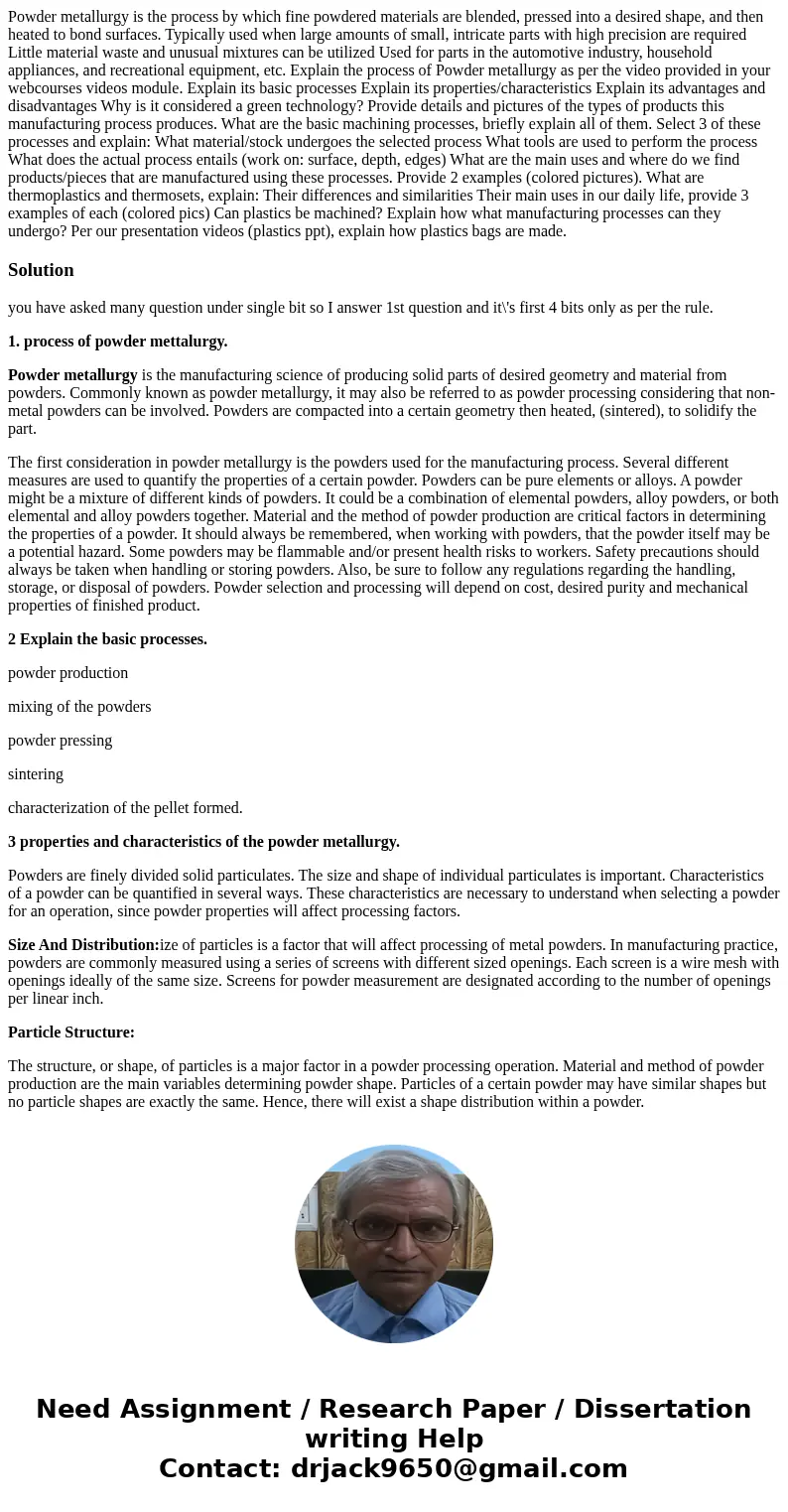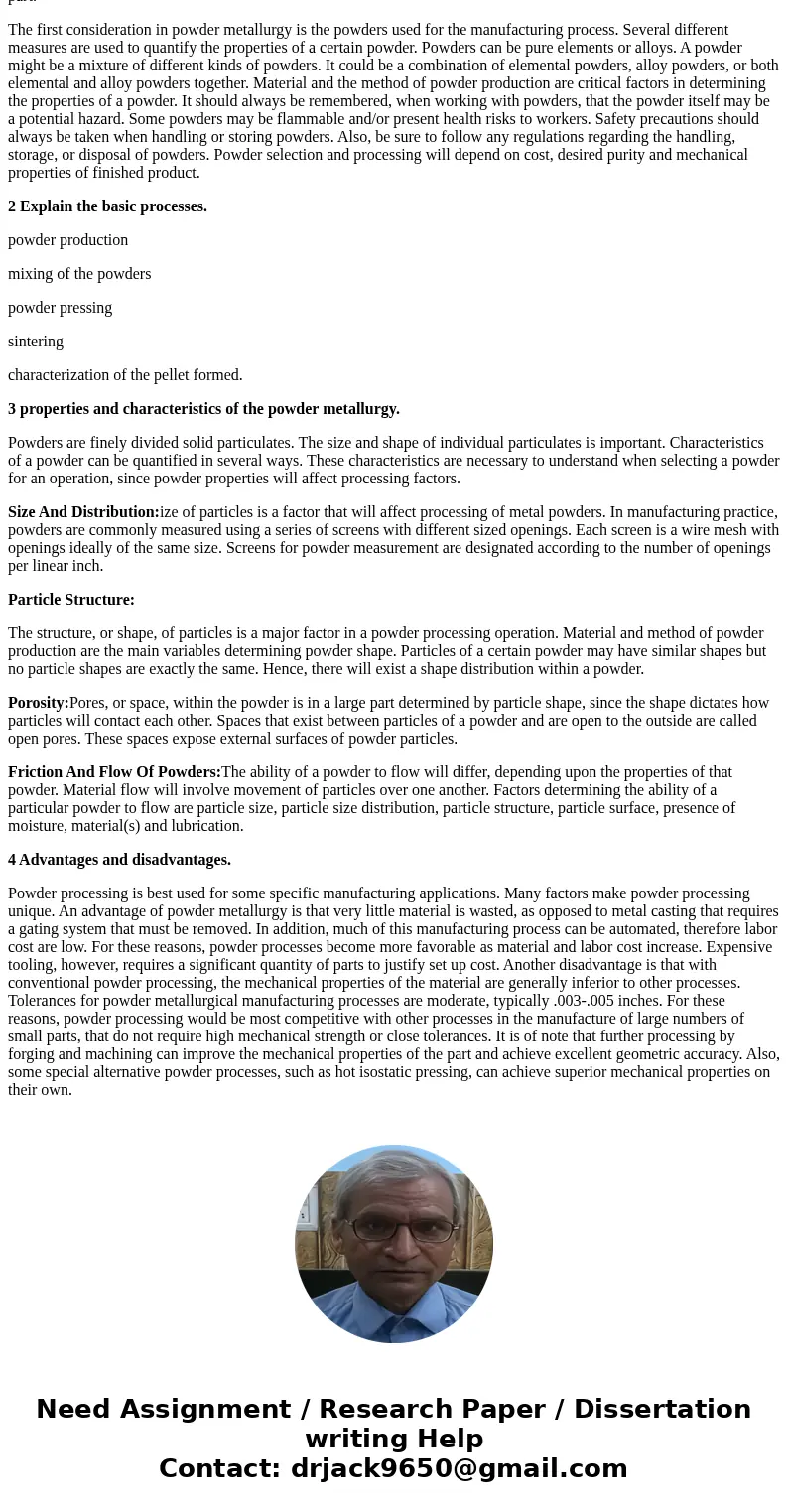Powder metallurgy is the process by which fine powdered mate
Solution
you have asked many question under single bit so I answer 1st question and it\'s first 4 bits only as per the rule.
1. process of powder mettalurgy.
Powder metallurgy is the manufacturing science of producing solid parts of desired geometry and material from powders. Commonly known as powder metallurgy, it may also be referred to as powder processing considering that non-metal powders can be involved. Powders are compacted into a certain geometry then heated, (sintered), to solidify the part.
The first consideration in powder metallurgy is the powders used for the manufacturing process. Several different measures are used to quantify the properties of a certain powder. Powders can be pure elements or alloys. A powder might be a mixture of different kinds of powders. It could be a combination of elemental powders, alloy powders, or both elemental and alloy powders together. Material and the method of powder production are critical factors in determining the properties of a powder. It should always be remembered, when working with powders, that the powder itself may be a potential hazard. Some powders may be flammable and/or present health risks to workers. Safety precautions should always be taken when handling or storing powders. Also, be sure to follow any regulations regarding the handling, storage, or disposal of powders. Powder selection and processing will depend on cost, desired purity and mechanical properties of finished product.
2 Explain the basic processes.
powder production
mixing of the powders
powder pressing
sintering
characterization of the pellet formed.
3 properties and characteristics of the powder metallurgy.
Powders are finely divided solid particulates. The size and shape of individual particulates is important. Characteristics of a powder can be quantified in several ways. These characteristics are necessary to understand when selecting a powder for an operation, since powder properties will affect processing factors.
Size And Distribution:ize of particles is a factor that will affect processing of metal powders. In manufacturing practice, powders are commonly measured using a series of screens with different sized openings. Each screen is a wire mesh with openings ideally of the same size. Screens for powder measurement are designated according to the number of openings per linear inch.
Particle Structure:
The structure, or shape, of particles is a major factor in a powder processing operation. Material and method of powder production are the main variables determining powder shape. Particles of a certain powder may have similar shapes but no particle shapes are exactly the same. Hence, there will exist a shape distribution within a powder.
Porosity:Pores, or space, within the powder is in a large part determined by particle shape, since the shape dictates how particles will contact each other. Spaces that exist between particles of a powder and are open to the outside are called open pores. These spaces expose external surfaces of powder particles.
Friction And Flow Of Powders:The ability of a powder to flow will differ, depending upon the properties of that powder. Material flow will involve movement of particles over one another. Factors determining the ability of a particular powder to flow are particle size, particle size distribution, particle structure, particle surface, presence of moisture, material(s) and lubrication.
4 Advantages and disadvantages.
Powder processing is best used for some specific manufacturing applications. Many factors make powder processing unique. An advantage of powder metallurgy is that very little material is wasted, as opposed to metal casting that requires a gating system that must be removed. In addition, much of this manufacturing process can be automated, therefore labor cost are low. For these reasons, powder processes become more favorable as material and labor cost increase. Expensive tooling, however, requires a significant quantity of parts to justify set up cost. Another disadvantage is that with conventional powder processing, the mechanical properties of the material are generally inferior to other processes. Tolerances for powder metallurgical manufacturing processes are moderate, typically .003-.005 inches. For these reasons, powder processing would be most competitive with other processes in the manufacture of large numbers of small parts, that do not require high mechanical strength or close tolerances. It is of note that further processing by forging and machining can improve the mechanical properties of the part and achieve excellent geometric accuracy. Also, some special alternative powder processes, such as hot isostatic pressing, can achieve superior mechanical properties on their own.


 Homework Sourse
Homework Sourse